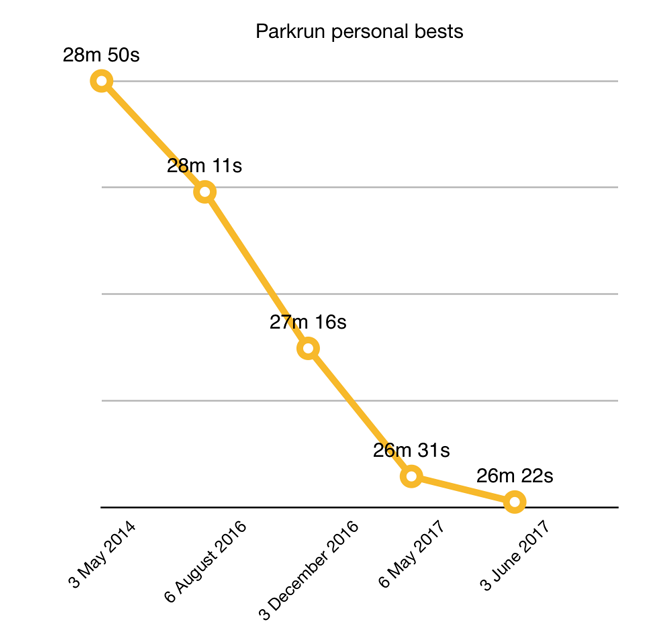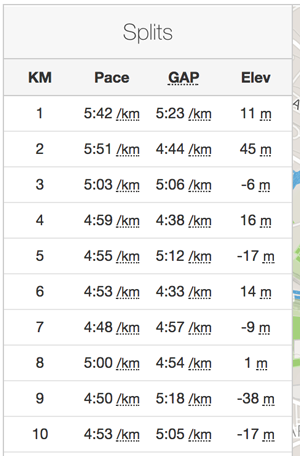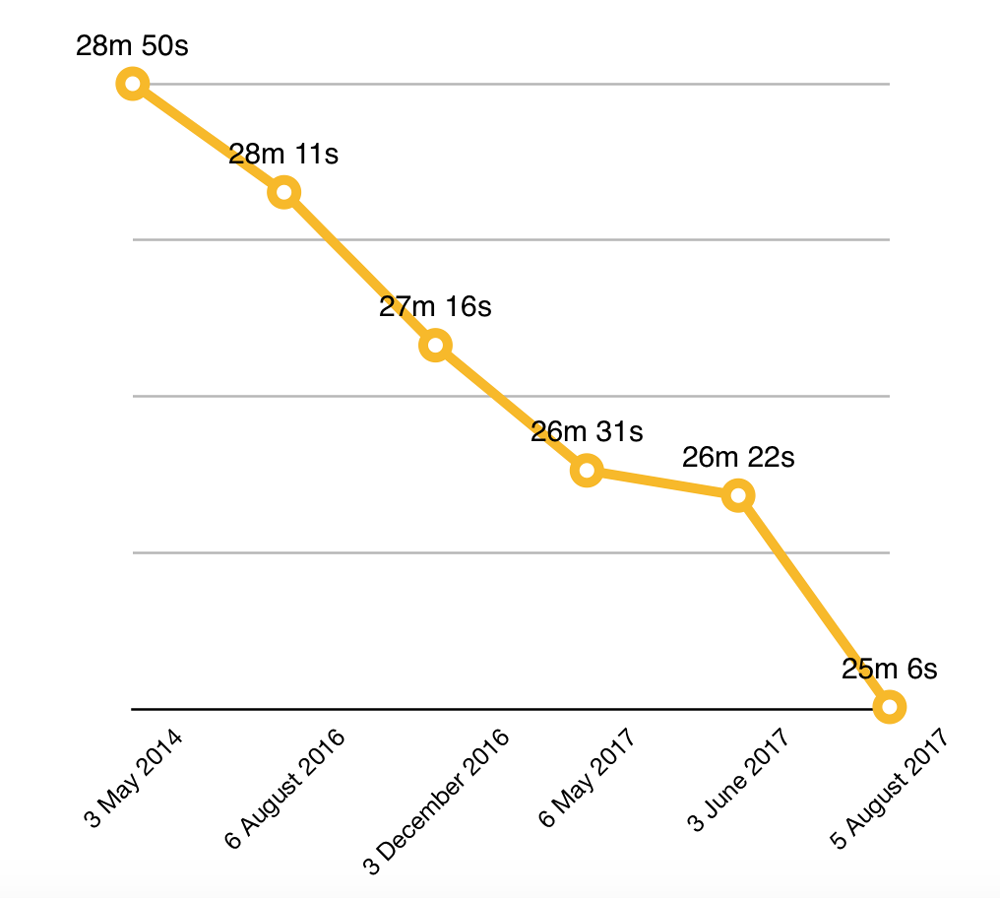For a long time, I’ve joked that I wanted to get my 5km run time down to Mo Farah’s… 10km time.
But this was never a joke. His personal best over 10,000m is 26:47, although this somewhat lags behind the world record of 26:17 set by Kenenisa Bekele in 2005. For years, my Parkun PB (personal best) was 28:50. Quite a long way behind…
Age grading
The 5km race pace is even quicker. That world record is held by Kenenisa Bekele, too. 12:37 set in 2004.
Then there is also a system called age grading. This is how it works:
They take the fastest recorded time that someone of your age and gender has run a specific distance. Then they give you a percentage based on that. So, if you match the time, you get 100%. If it takes you twice as long, you get 50%. Four times as long, 25%, etc.
The fastest a 30-year-old male has run 5km is 13:01. Therefore, to achieve a 50% grading, I would have to run 26:02. Even tougher than matching the 10k world record, of course.
A sensational year
The last year or so have been great for my running. I’ve taken 10 minutes off my 10k time and 24 off my half marathon (though to be fair, I’ve only done two and the first one was in 25-degree heat).
You can read more about my 10km races here and half marathons here.
But my 5km times have been tumbling too…

Note that these dates are evenly spaced on the chart, but not in time. I set my PB on my 3rd ever Parkrun back in 2014 and then did not better it until a year ago. Since then, I’ve set an additional three personal bests.
The stage is set
When I turned up to Parkrun last Saturday, I was feeling okay. Not amazing, but fine.
I noticed they had pacers, so I went over to the other side. I’ve been struggling to keep my time under 27 minutes: only managed it four times, including the two PBs. Therefore, I decided to follow the 27-minute pacer and make sure I was ahead of him.
As we raced down the first straight, I saw the 26-minute pacer just ahead. So, I thought “what the hell: I need to be somewhere around him anyway” and jumped across.
It was hard going. At around 3km I started falling behind. Which is fine, expected almost, given I had never hit 26 minutes. But the roar of the marshalls and the fact that, probably for the first time ever, I managed to avoid being lapped, I got back on his tail.
As we hit 4km he confessed that we were running ahead of schedule. He slowed down a little and a cat and mouse game began as he dropped behind me, before catching up each time I tried to draw breath.
For 500 metres this continued until we entered the back straight. At “the hill” (in quote marks because it only goes up two metres, but it is surprising how many people slow down) I was loudly groaning. But as we reached the top I decided to give it one last push and went clear of him.
As I rounded the final corner, I saw a beautiful sight for tired eyes: the 25-minute pacer wasn’t that far ahead of us. I found I had renewed energy for the final kick as I chased him down with all my will.
And missed him.
It was too much ground to make up. But that did not matter. I finished a mere six seconds behind him, giving me a time of 25:06. One minute 18 seconds faster than my previous PB, faster than the 10km world record and giving me a 51.53% on the age grading; the first time I had ever been over 50%.

How did that happen?
Let’s put things into context here. Despite my attempt at epic storytelling, 25:06 is not that fast for a 30-year-old healthy man to be running 5km. But, given how much of an improvement it was over my previous PB, it is worth considering what was different.
Here are some ideas:
The time was incorrect. This was my first thought. Parkrun timings are often out, sometimes significantly. But there are a few reasons to believe this one is correct.
First, I was just six seconds behind the 25-minute pacer. Second, I was well ahead of the 26-minute pacer. Third, Strava had my km splits at significantly faster than usual.
Both Strava and MapMyRun report me running at 5:00 to 5:20 minutes per km. This would give me a typical run time of 26 minutes. But it never works out like that. However, measuring the differences, I clearly did beat the 5:00 per km on this occasion.

It’s also difficult to measure my exact time on the app because I start it from when I leave home, and stop it when I return home. So the Parkrun itself is from 2.5 km into the run and ends 7.5 in.
So, given that the Parkrun time and the pacers’ times agree, and my Strava report agrees I was on a good day, it suggests the time is accurate.
It could be that the time was off in my recent 27 and 28-minute runs, which were actually faster. I have, for example, comfortably beaten the 27-minute pacer before and been given a 27+ time.
I have new trainers. I had completely worn through the soles of my old running shoes, so I gave in and bought some new ones. It may be that they contributed to recent runs. This is only my second Parkrun in them.
I have been cross training. I have played a lot of basketball at work recently, and I’ve also been back in the pool a few times. Not many, but it could have helped.
I was just on a really good day. As an amateur runner, my performance is not very predictable. It could have been that I was just on a really good day.
And now the chart looks like this

Maybe there is hope for my hitting my target time in this year’s Abbey Dash after all.
Don't have time to check my blog? Get a weekly email with all the new posts. This is my personal blog, so obviously it is 100% spam free.
Tags: running
This entry was posted on Thursday, August 10th, 2017 at 11:00 am and is filed under Sport. You can follow any responses to this entry through the RSS 2.0 feed. Both comments and pings are currently closed.